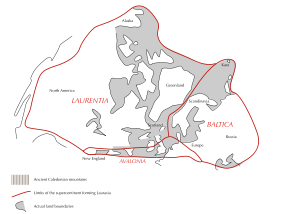- Euramerica
-
Euramerica (also known as Laurussia, the Old Red Continent or the Old Red Sandstone Continent) was a minor supercontinent created in the Devonian as the result of a collision between the Laurentian, Baltica, and Avalonia cratons (Caledonian orogeny). 300 million years ago in the Late Carboniferous tropical rainforests lay over the equator of Euramerica. A major, abrupt change in vegetation occurred when the climate aridified. The forest fragmented and the lycopsids which dominated these wetlands thinned out, being replaced by opportunistic ferns. There was also a great loss of amphibian diversity and simultaneously the drier climate spurred the diversification of reptiles. [1]
Contents
Extent
Euramerica became a part of the major supercontinent Pangaea in the Permian. In the Jurassic, when Pangaea rifted into two continents, Gondwana and Laurasia, Euramerica was a part of Laurasia.
In the Cretaceous, Laurasia split into the continents of North America and Eurasia. The Laurentian craton became a part of North America, while Baltica became a part of Eurasia.
Events
Carboniferous: Climate change devastated tropical rainforests, fragmenting the forests into isolated 'islands' and causing the extinction of many plant and animal species during the Carboniferous Rainforest Collapse (CRC).
Permian: Euramerica became a part of the major supercontinent Pangaea
Jurassic: Pangaea rifted into Gondwana and Laurasia
Cretaceous: Laurasia split into the continents of North America and Eurasia.
References
- ^ Sahney, S., Benton, M.J. & Falcon-Lang, H.J. (2010). "Rainforest collapse triggered Pennsylvanian tetrapod diversification in Euramerica" (PDF). Geology 38 (12): 1079–1082. doi:10.1130/G31182.1. http://geology.geoscienceworld.org/cgi/content/abstract/38/12/1079.
See also
External links
Continents Historical continentsArctica · Asiamerica · Atlantica · Avalonia · Baltica · Cimmeria · Congo craton · Euramerica · Kalaharia · Kazakhstania · Laurentia · North China · Siberia · South China · East Antarctica · IndiaSubmerged continents
Kerguelen Plateau · ZealandiaMythical and theorized continents
Atlantis · Kumarikkandam · Lemuria · Meropis · Mu · Terra AustralisSee also Regions of the world
This palaeogeography article is a stub. You can help Wikipedia by expanding it.












